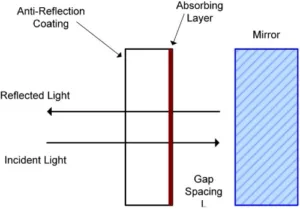Researchers at Qualcomm MEMS Technologies have developed a new display, using a mirror and an absorbing layer to take advantage of the wave properties of natural light. The development is the latest version of Qualcomm’s reflective Mirasol technology (Display Monitor Vol 15 No 19).
Mirasol displays use ambient light and mirrors to produce a colour image (for more on the technology, see http://tinyurl.com/lzftpty). The new design is based on a colour rendering format that has been christened ‘Continuous Colour’. The display can be always-on with low power draw, and will work in high ambient light.
A mirror with a thin absorbing layer – separated by a ‘precise and controllable’ gap – was used in the new display. The mirror, of course, reflects ambient light. The absorbing layer filters out a narrow slice of the spectrum, to colour this reflected light. Control of the gap enables reproduction of ‘nearly every conceivable colour’ – not just red, green and blue.
Traditional reflective displays used three separate pixels to produce red, green and blue colours. This causes brightness to be limited, as only a third of the reflected light was being used. The new display reflects more of the incoming light and enables a full spectrum of colours – including bright white and deep black, says the team.
This was possible using a property of light called interferometric absorption, which uses light waves. The light passing through the absorbing layer is reflected back from the mirror. Incoming light and reflected light thus interfere with one another; they produce a variety of standing waves. with each component periodicity producing a unique colour in the spectrum.
The gap between the mirror and absorbing layer is adjusted using MEMS devices. The absorbing layer can be moved to match a node in the standing wave that corresponds to a desired colour. The spectral components of the light that are not associated with that colour are absorbed, so only the desired colour leaks through and returns to the viewer. This means that each pixel can act as a coloured mirror.
Power savings can exceed backlit technologies, depending on how the display is used. The greatest savings come when showing a static image.
While the journal paper (http://tinyurl.com/ncb8323) describes a 1.5″ display with approximately 149,000 pixels, the technology size and resolution can be scaled to match those of various mobile devices – including smartphones.
Fabrication can be achieved in one piece. The MEMS, upper layer and lower layer can be created using the same deposition, lithography and etching processes that are used to create LCD displays.

